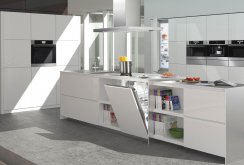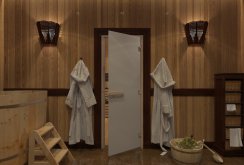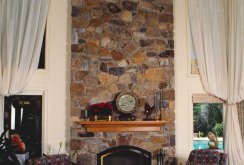Ceiling systems: everything you need to know about modern systems
The modern apartments are composed of many details. A catalog from leading manufacturers of attributes for the home is sometimes simply shocking with its variety and wide possibilities for implementing the most incredible ideas. The ceiling has long ceased to be positioned as one of the working surfaces in the decoration of the room. Now a completely different format is relevant - ceiling systems. Our review will allow you to become more familiar with the finishing materials and other elements to create advanced designs.Types of ceiling systems in functionality
False ceiling - a system consisting of a reliable frame and parts, forming the main canvas. As modular systems use different materials by type, texture, origin. According to the functional purpose, the experts will single out the following types of systems:- Suspended technological systems (economy light), which are distinguished by special efficiency and minimal energy consumption. Most often used for landscaping spacious rooms in entertainment centers and administrative institutions;
- Functional tiled compositions that combine the highest technological standards. Use systems in rooms to which increased demands are made. Parameters can be very different: acoustics, hygiene, resistance to moisture, mechanical damage, chemical "attacks";
- Design ceilings are luxurious compositions with a special aesthetic content. Designer refinements are most often necessary for the refinement of modern residential apartments. However, systems with increased aesthetic value can complement the exclusive interior of various entertainment venues (restaurants, clubs, cafes).
Ceiling systems by type of material
All systems are conventionally divided into tile and rack structures, depending on what type of filler for the frame was chosen. A potential buyer decides which format is most suitable for him. However, comparisons deserve not so much structural elements as the materials themselves from which they are made. Ceiling systems according to the type of materials are divided into the following types:- Gypsum plasterboard;
- Wooden systems;
- From the lining;
- Laminate sheets;
- Plastic panels;
- Siding canvas;
- Coffered;
- Fabric;
- Glass.
Ceiling systems: attention to detail
Ceiling systems are not only a framework and placeholders, but also a mass of various auxiliary components. Their task is to make ceiling structures functional, aesthetically attractive, exclusive and unusual. The following options are possible:- Acoustic components;
- Cooker hood;
- Cornice (curtains, pears);
- Hatches and similar elements;
- Ceiling drying attributes;
- Ceiling mounted heaters.
Types of ceiling systems by type of repair work
In order for ceiling systems to fulfill the missions assigned to them, it is important to take care of a number of nuances during the repair phase. Considering systems for the improvement of the ceiling, experts identify the following components:- Special tools for processing paintings that protect the material from "biological attacks" (impregnation against mold, fungus, other microorganisms);
- Waterproofing;
- Vapor barrier;
- Thermal insulation;
- Soundproofing;
- Primer;
- Web alignment (closing holes, strengthening the web, eliminating cracks and gaps);
- Fire fighting systems and other specific devices.








